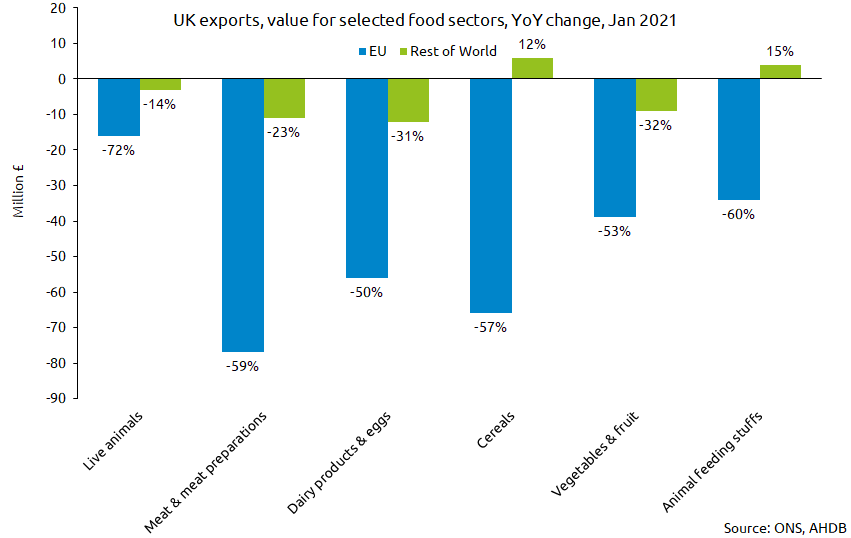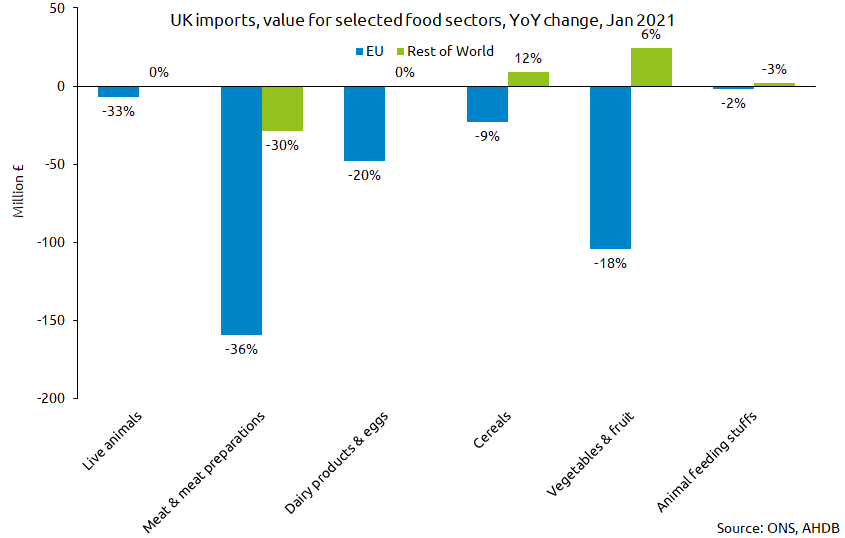Latest trade data – What does it tell us about the EU Exit impact on agrifood products?
Friday, 12 March 2021
The Office of National Statistics (ONS) today (12 March) released January trade data, giving us the first insight to how the reported trade frictions have actually affected the value of trade. It is worth noting that while EU exit has undoubtedly had an impact on trade, there are other factors at play that are potentially distorting the data. The Coronavirus pandemic, stockpiling in the run up to EU exit and various difficulties on collecting data throughout the pandemic, will be impacting on January’s figures, as well as the last 12 months, as detailed by the ONS. The true impact of leaving the EU may not be able to be determined for a number of months.
For the agriculture sector, trade in January has been heavily impacted by these factors. Overall food and live animal exports are down 46% in value terms (-£545 million) compared to January 2020, although food and live animals exports to just the EU are down by around 59%, from £793m to £323m. Within the agricultural industry, the meat sector is among the hardest hit, with exports to the EU down by 59%, from £130m to £53m. Exports to the rest of the world for food and live animals are down around 19%, which indicates that factors beyond the new trading requirements with the EU are also affecting trade.

Meanwhile, imports of food and live animals from the EU have fallen by 21% in January 21 compared to 12 months ago. This is likely indicative of the fact that the UK has implemented a phased introduction to border checks and so UK importers/EU exporters aren’t currently facing the same burden of paperwork or checks that the products going out of the UK are. The phased approach was due to begin in April, with additional paperwork required to be filled out for UK imports, however, it was announced yesterday that the implementation of this would be delayed:
- Pre-notification and export health certification for animal products will not be required until 1 October 2021, and for low-risk plant and plant products until 1 January 2022.
- Physical checks at the border will not take place on a range of agri-food products and high-risk plants until 1 January 2022. These will be carried out at Border Control Posts.
- Physical checks on live animals and low-risk plants and plant material will not take place until March 2022. These will be carried out at Border Control Posts.

Like with UK exports, meat products have been the most affected, but vegetables and fruit have also suffered significantly. Going forward, AHDB will be looking into each sector in more detail as well as monitoring trade data as the year progressives which will give a more accurate picture of the full implication of Brexit.
Watch our webinar, where exporters talk about their experiences since January 1 and their hopes for the future
Listen to our podcast on trade friction
Sign up for our upcoming webinar looking specifically at EU exit for the red meat sector.

As of January 2021 data, the way HMRC collects trade data has changed, which will be reflected in the trade statistics. Comparisons between this and historic data should be treated with caution, and may well be subject to future revisions
Topics:
Sectors:
Tags:

